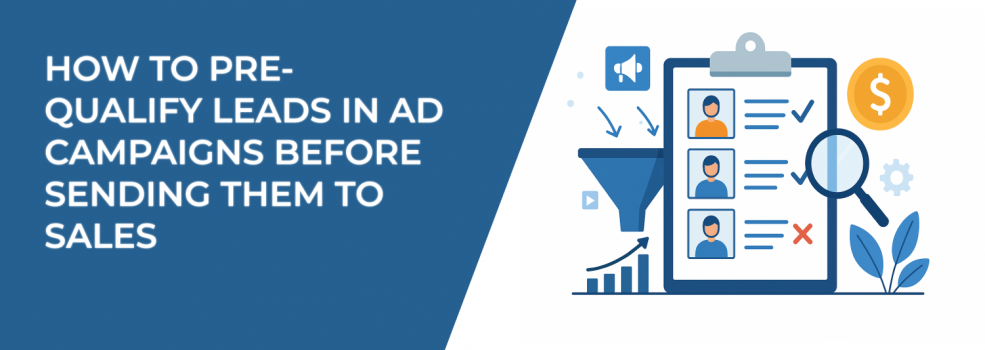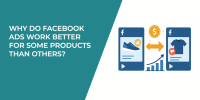You’ve built the campaign. The ad copy is sharp. The targeting looks airtight. Clicks start rolling in — but your sales team is overwhelmed with leads that go nowhere.
Sound familiar?
Pre-qualifying leads isn’t just a “nice-to-have.” It’s the difference between ad campaigns that create real revenue and ones that just waste budget. In this guide, we’ll walk through how to filter out the noise before leads hit your sales funnel.
Because great ads don’t just attract attention — they attract the right attention.
Why Pre-Qualification Matters
Leads aren’t all created equal. Some are ready to buy. Others are just browsing. Some aren’t even your target audience.
If you send every click to sales, they’ll waste time chasing low-quality prospects. Worse, they’ll burn out. And if sales starts ignoring leads, even the good ones will fall through the cracks.
Pre-qualification solves this.
By filtering and segmenting leads before they hit your CRM, you improve close rates, shorten sales cycles, and spend less on acquisition over time. For a broader view of what works in today's landscape, check out Mastering Lead Generation in 2025: Top Tactics for Success.
1. Use Lead Forms to Qualify — Not Just Collect
Facebook Lead Ads, LinkedIn Forms, or your landing pages — these are your first filter.
But most advertisers ask only for name, email, phone. That’s fine for volume. Not so much for quality.
Instead, add qualifying questions like:
-
What’s your monthly ad spend?;
-
Are you currently working with an agency?;
-
How soon are you looking to get started?
These might lower your submission rate. That’s okay. A smaller list of higher-intent leads will outperform a bloated one every time.
Want to improve your approach without scaring leads away? Here's a helpful read on How to Qualify Leads Through Facebook Ads Without Adding Friction.
Just don’t go overboard. Three to four qualifying fields is often the sweet spot — enough to filter, not enough to scare off legitimate prospects.
2. Segment Clicks With Pre-Landing Pages
Instead of sending all ad traffic directly to a sales booking form, try adding a “bridge page.”
This is a short page — often just a headline, a few bullets, maybe a quick video — that does two things:
-
Repeats and expands your offer;
-
Lets users self-qualify by clicking the next CTA.
Think of it as a fork in the road. Those who click through are already more engaged. Those who bounce? They weren’t serious in the first place.
You can also A/B test messaging here. Adjust pain points, benefits, and even pricing hints to filter for high-value intent.
3. Score Leads Automatically
Lead scoring isn’t just for big enterprise tools.
If you’re using a CRM like HubSpot, Zoho, or Pipedrive, you can assign scores based on:
-
Ad source or campaign;
-
Responses to form fields;
-
On-site behavior (scroll depth, time on page, etc.);
-
Email engagement (opens, clicks).
Then, route leads accordingly:
-
Hot leads → Sales call;
-
Warm leads → Email nurture sequence;
-
Cold leads → Retargeting audience.
This way, your sales reps spend time where it actually counts.
4. Ask Qualifying Questions in the Ad Itself
Want fewer bad leads? Set expectations before the click.
Use copy that says things like:
-
“For e-commerce brands spending $5K+/mo on ads”;
-
“Only for marketers ready to scale fast”;
-
“Not for early-stage startups.”
You’re not trying to exclude people — you’re being clear about who the offer is for.
This tactic doesn’t just improve lead quality. It builds trust. People appreciate honesty, and it’ll reduce friction later in your funnel.
If you’re still figuring out who to target, start with How to Define a Target Audience for Marketing: A Step-by-Step Guide.
5. Use Chatbots or Instant Messaging Filters
Running click-to-Messenger or WhatsApp ads? You can qualify leads right inside the chat.
Use auto-responses or flows that ask:
-
What industry are you in?;
-
What’s your biggest marketing challenge?;
-
What kind of support are you looking for?
Based on answers, you can either:
-
Push qualified leads to a live rep;
-
Route others to a resource;
-
Or end the conversation politely.
Think of this as a real-time pre-qualification filter that happens before the lead even touches your main pipeline.
6. Build Separate Funnels for Different Audiences
If you’re targeting multiple segments (e.g., agencies, freelancers, and in-house marketers), don’t jam them into the same funnel.
Instead, create audience-specific ads and landing pages with tailored messaging and pre-qualification paths.
Why? Because each group has different pain points, budgets, and timelines. Mixing them creates noise.
Need help refining your targeting? Facebook Ad Targeting 101: How to Reach the Right Audience offers a great foundation.
7. Measure What Happens After the Click
Too many advertisers stop at the click-through rate. But if you want better leads, you need to dig deeper.
Ask yourself:
-
Which campaign sends leads that actually book a call?;
-
Which headlines lead to the highest CRM scores?;
-
Which traffic source results in the fastest closes?
If you’re not connecting your ad platform to your CRM or analytics stack, you’re flying blind.
Use UTM tracking, CRM integrations, and even simple spreadsheet exports to compare ad spend → qualified leads → deals closed.
Also, make sure you’re using the right type of campaign from the start. Not sure whether to focus on lead gen or conversions? Lead Generation Ads vs Conversion Campaigns: What’s Better for You? breaks it down clearly.
Final Thoughts
Pre-qualifying leads in ad campaigns isn’t a luxury. It’s a necessity for any advertiser serious about ROI.
You don’t need fancy tech or a huge team. Just a clear understanding of who you want — and a system to filter out who you don’t.
Get this right, and your sales team will stop complaining about “bad leads.” They’ll be too busy closing deals.

